Shoah (Claude Lanzmann, 1985)
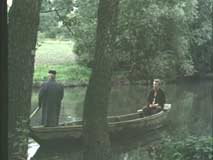 “I can’t believe I’m here,”
utters Simon Srebnik, the devastated survivor that Claude Lanzmann’s landmark
Holocaust documentary Shoah first
introduces us to. Brought back to the grounds of the death camp from which he
miraculously escaped forty years earlier, the man is confronted with a past that
clearly has faded more from the physical world than his mental one. Watching him
as he combs over the area that once served as his prison and listening as he
recollects the details of the camp, one gets a true appreciation of the impact
that Simon’s ordeal has had on his mindset. In Shoah,
a nine-and-a-half hour opus that focuses on history without using any archival
footage at all, it’s the world of memory and personal experience that
effectively describe to us the infamous massacres of the past. Primarily
concentrating on extermination process at Sobibor, Treblinka, and Auschwitz, the
film is undeniably tough going, but by looking into the hearts of the people
that experienced the atrocities, it gets at the heart of the horror itself.
“I can’t believe I’m here,”
utters Simon Srebnik, the devastated survivor that Claude Lanzmann’s landmark
Holocaust documentary Shoah first
introduces us to. Brought back to the grounds of the death camp from which he
miraculously escaped forty years earlier, the man is confronted with a past that
clearly has faded more from the physical world than his mental one. Watching him
as he combs over the area that once served as his prison and listening as he
recollects the details of the camp, one gets a true appreciation of the impact
that Simon’s ordeal has had on his mindset. In Shoah,
a nine-and-a-half hour opus that focuses on history without using any archival
footage at all, it’s the world of memory and personal experience that
effectively describe to us the infamous massacres of the past. Primarily
concentrating on extermination process at Sobibor, Treblinka, and Auschwitz, the
film is undeniably tough going, but by looking into the hearts of the people
that experienced the atrocities, it gets at the heart of the horror itself.
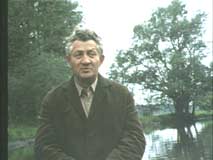 Instead of presenting a series of cold
facts about the Holocaust, Shoah
confronts us with the firsthand accounts of those people that actually
experienced the events in question. By doing that, it makes us simultaneously
aware of the specifics and the long-term repercussions of the Holocaust. Healing
seems inexorably tied in with the process of forgetting for these people, and
since they are unable to forget what happened to them, it seems as if that
healing might be impossible, until it becomes apparent that many of the people
being questioned have repeated the stories they tell so many times that they
have become distanced from them. Shoah contains
interviews of dozens of people conducted by Lanzmann in French, German, English
and Polish. At times, it doesn’t feel as if he’s pulling information from
them that they haven’t before revealed. At the same time, the interviewees
seem to have told, retold and relived the stories until they have moved from the
realm of impression and personal memory into something as concrete as a
historical fact, and in that process, the movie mines genuine conflict from the
symbiotic processes of healing and forgetting. The rare moments when the
distance between past and present evaporates, and the teller recalls the past
with the intensity of the present are the best, and most painful, in the movie
(is it Lanzmann’s inadequacy as an interviewer there aren’t more of them?),
because in them we hear the unspeakable as it is once again spoken. During times
like those, Lanzmann’s decision to not use archival footage seems completely
moot, since any gap between past and present is bridged completely.
Instead of presenting a series of cold
facts about the Holocaust, Shoah
confronts us with the firsthand accounts of those people that actually
experienced the events in question. By doing that, it makes us simultaneously
aware of the specifics and the long-term repercussions of the Holocaust. Healing
seems inexorably tied in with the process of forgetting for these people, and
since they are unable to forget what happened to them, it seems as if that
healing might be impossible, until it becomes apparent that many of the people
being questioned have repeated the stories they tell so many times that they
have become distanced from them. Shoah contains
interviews of dozens of people conducted by Lanzmann in French, German, English
and Polish. At times, it doesn’t feel as if he’s pulling information from
them that they haven’t before revealed. At the same time, the interviewees
seem to have told, retold and relived the stories until they have moved from the
realm of impression and personal memory into something as concrete as a
historical fact, and in that process, the movie mines genuine conflict from the
symbiotic processes of healing and forgetting. The rare moments when the
distance between past and present evaporates, and the teller recalls the past
with the intensity of the present are the best, and most painful, in the movie
(is it Lanzmann’s inadequacy as an interviewer there aren’t more of them?),
because in them we hear the unspeakable as it is once again spoken. During times
like those, Lanzmann’s decision to not use archival footage seems completely
moot, since any gap between past and present is bridged completely.
 Lanzmann structures Shoah
in a way that encourages the viewer to ponder questions of individualism and
history. At first, it jumps around often among storytellers to establish its
scope, and then, as it moves on, the film begins to switch narrators less
frequently. This lends a larger context to the tales we hear that the tellers
themselves scarcely seem aware of. Oftentimes, Lanzmann juxtaposes people who
are still exceptionally emotional about their experiences with those that have a
more distanced, disbelieving response, putting us in a position where we have to
measure not only the fact itself, but also the effect that that fact has had on
these people. We hear men describe how they would make a throat-cutting gesture
toward the incoming Jews as they arrived at the death camps, but we find that
while one did it as a sympathetic warning, the other did it mostly to taunt. In
another strong sequence, two survivors from the camps describe radically
different accounts of their arrivals in the camps. One man talks about a
surprising, and ultimately deceptive cordiality from the guards, while the other
talks of an exceptionally brutal experience filled with tumult and confusion.
Who is telling the truth at any given moment becomes irrelevant almost, since we
can only observe the net effect that these people’s experiences have had on
them. The past, whatever it might have been, is being inescapably defined by the
present.
Lanzmann structures Shoah
in a way that encourages the viewer to ponder questions of individualism and
history. At first, it jumps around often among storytellers to establish its
scope, and then, as it moves on, the film begins to switch narrators less
frequently. This lends a larger context to the tales we hear that the tellers
themselves scarcely seem aware of. Oftentimes, Lanzmann juxtaposes people who
are still exceptionally emotional about their experiences with those that have a
more distanced, disbelieving response, putting us in a position where we have to
measure not only the fact itself, but also the effect that that fact has had on
these people. We hear men describe how they would make a throat-cutting gesture
toward the incoming Jews as they arrived at the death camps, but we find that
while one did it as a sympathetic warning, the other did it mostly to taunt. In
another strong sequence, two survivors from the camps describe radically
different accounts of their arrivals in the camps. One man talks about a
surprising, and ultimately deceptive cordiality from the guards, while the other
talks of an exceptionally brutal experience filled with tumult and confusion.
Who is telling the truth at any given moment becomes irrelevant almost, since we
can only observe the net effect that these people’s experiences have had on
them. The past, whatever it might have been, is being inescapably defined by the
present.
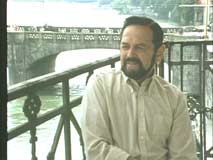 Perhaps as its most valuable service, Shoah demonstrates that history, while necessarily comprised of the
personal accounts of people, is bigger than the account of any individual. No
single person interviewed can give the whole story, but all of them realize how
their personal experience was less than the total experience, both during the
War and after, and that clearly causes them to feel guilt. We find out that
during the War, workers in the camp couldn’t use words like “corpse”, and
we begin to understand that sort of control of information directly contributed
to the Nazi’s methods of crowd control. They seized onto the fact that people
show a consistent unwillingness or inability to look at the big picture.
Lanzmann’s film posits that the role of the artist, historian, reporter or
documentarian is to help us compose that big picture, and as the movie
progresses it encourages the viewer to paint his or her own impression of the
past.
Perhaps as its most valuable service, Shoah demonstrates that history, while necessarily comprised of the
personal accounts of people, is bigger than the account of any individual. No
single person interviewed can give the whole story, but all of them realize how
their personal experience was less than the total experience, both during the
War and after, and that clearly causes them to feel guilt. We find out that
during the War, workers in the camp couldn’t use words like “corpse”, and
we begin to understand that sort of control of information directly contributed
to the Nazi’s methods of crowd control. They seized onto the fact that people
show a consistent unwillingness or inability to look at the big picture.
Lanzmann’s film posits that the role of the artist, historian, reporter or
documentarian is to help us compose that big picture, and as the movie
progresses it encourages the viewer to paint his or her own impression of the
past.
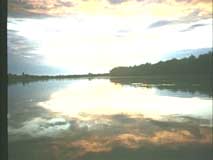 Shoah’s editing rhythms have a cyclic structure that enhances the
understanding that the slaughters of the Holocaust weren’t a one-off affair.
The images move from train tracks to talking heads to placid green fields and
back again, and that cycle reflects the repeating succession of Holocaust horror
that reoccurred every time a train pulled into one of the camps. Though
Lanzmann’s interviews don’t explicitly ask us to indict the people who did
nothing as they saw trainload after trainload of people go to their deaths, his
arrangement of scenes makes his stance clear. The poetic landscapes he opts to
include belie the events that unfolded there and suggest that even Nature might
be capable of easily forgetting to awful acts that marked its soil. In Shoah, even the
cemeteries, which were created to memorialize the past, are dilapidated and seem
to come a far-off era. The movie is irrevocably stuck in the present, and it
mourns that it can’t better examine what’s happened from that vantage point.
Lanzmann’s aesthetic approach here is one that doesn’t (and basically
can’t) develop, but it’s undeniably haunting and thought provoking.
Shoah’s editing rhythms have a cyclic structure that enhances the
understanding that the slaughters of the Holocaust weren’t a one-off affair.
The images move from train tracks to talking heads to placid green fields and
back again, and that cycle reflects the repeating succession of Holocaust horror
that reoccurred every time a train pulled into one of the camps. Though
Lanzmann’s interviews don’t explicitly ask us to indict the people who did
nothing as they saw trainload after trainload of people go to their deaths, his
arrangement of scenes makes his stance clear. The poetic landscapes he opts to
include belie the events that unfolded there and suggest that even Nature might
be capable of easily forgetting to awful acts that marked its soil. In Shoah, even the
cemeteries, which were created to memorialize the past, are dilapidated and seem
to come a far-off era. The movie is irrevocably stuck in the present, and it
mourns that it can’t better examine what’s happened from that vantage point.
Lanzmann’s aesthetic approach here is one that doesn’t (and basically
can’t) develop, but it’s undeniably haunting and thought provoking.
 Shoah reduces itself at times, however, and becomes less than the
masterpiece that it might otherwise be. For example, during one sequence, we
hear a woman named Inge lamenting that Berlin is “no longer home” while the
camera shows us modern images of the prospering cityscape. The sequence reflects
Inge’s guilt, but at the same time, it seems to be shouting with rage that
people go on without giving more acknowledgment to the suffering of the Jews.
There are other ways in which Shoah is
not as complex as The Sorrow and the Pity,
which is still the supreme WWII documentary. The focus on discovering history
through personal accounts is gone about in an oddly impersonal way. We find out
about the people that are questioned only to the extent that they were
associated with the death camps. What happened after the camps or how it changed
their lives, remains too aloof, and that only makes the film seem obsessed with
death and suffering. I found myself yearning for more of an outlook at times
than “if we forget, we’re doomed to repeat ourselves.” The tone of the
film feels like Apocalypse Now’s Col. Kurtz repeating
“the horror… the horror…”, and while no one can disagree with that
sentiment, it probably would make for a more inquisitive film if Lanzmann was
able to sidestep that reaction more often.
Shoah reduces itself at times, however, and becomes less than the
masterpiece that it might otherwise be. For example, during one sequence, we
hear a woman named Inge lamenting that Berlin is “no longer home” while the
camera shows us modern images of the prospering cityscape. The sequence reflects
Inge’s guilt, but at the same time, it seems to be shouting with rage that
people go on without giving more acknowledgment to the suffering of the Jews.
There are other ways in which Shoah is
not as complex as The Sorrow and the Pity,
which is still the supreme WWII documentary. The focus on discovering history
through personal accounts is gone about in an oddly impersonal way. We find out
about the people that are questioned only to the extent that they were
associated with the death camps. What happened after the camps or how it changed
their lives, remains too aloof, and that only makes the film seem obsessed with
death and suffering. I found myself yearning for more of an outlook at times
than “if we forget, we’re doomed to repeat ourselves.” The tone of the
film feels like Apocalypse Now’s Col. Kurtz repeating
“the horror… the horror…”, and while no one can disagree with that
sentiment, it probably would make for a more inquisitive film if Lanzmann was
able to sidestep that reaction more often.
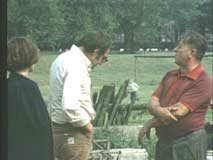 Shoah is definitely a milestone in the history of the documentary film, but
a lot of the material it contains has been dramatized or regurgitated in lesser
nonfiction and fiction films. That there’s an air of redundancy about it in
this day and age proves that it served its purpose by creating a dialogue about
the travesties of the Holocaust. Also, as with any film of such an exceptional
running time, one has to question whether or not the length is “necessary”.
If you look at Shoah as a historical
document, then it is all worthwhile, but if you see it primarily as a work of
cinema, it might be less justified, since it repeats itself stylistically and
hammers the same point home consistently. In any case, complaints of Shoah’s
length have less weight, with the film’s availability on home video and DVD.
It is important to let the viewer stop the film at any time, here because it
makes it feel less like self-punishment and more like self-edification. Good
intentions or not, watching Shoah in a
theater would be a difficult task indeed.
Shoah is definitely a milestone in the history of the documentary film, but
a lot of the material it contains has been dramatized or regurgitated in lesser
nonfiction and fiction films. That there’s an air of redundancy about it in
this day and age proves that it served its purpose by creating a dialogue about
the travesties of the Holocaust. Also, as with any film of such an exceptional
running time, one has to question whether or not the length is “necessary”.
If you look at Shoah as a historical
document, then it is all worthwhile, but if you see it primarily as a work of
cinema, it might be less justified, since it repeats itself stylistically and
hammers the same point home consistently. In any case, complaints of Shoah’s
length have less weight, with the film’s availability on home video and DVD.
It is important to let the viewer stop the film at any time, here because it
makes it feel less like self-punishment and more like self-edification. Good
intentions or not, watching Shoah in a
theater would be a difficult task indeed.
60
10-08-03
Jeremy Heilman